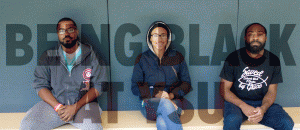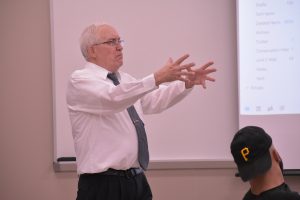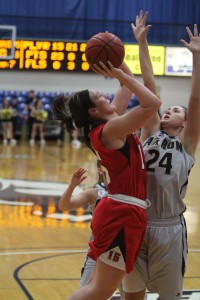
By Justin Wier & Liam Bouquet
Sidney Watkins came to Youngstown State University from the Bahamas to study mechanical engineering. One day he went to a professor for help, and the professor said “a lot of you guys don’t make it in the engineering department.”
“I looked at him like, ‘what does that mean?’” Watkins said. “‘Are you expecting me to fail right now?’ I felt like I came to the wrong school. I felt like they weren’t interested in my education … I really felt like, ‘Okay, this is for whites only.’”
Several black students across Youngstown State University report feeling a sense of alienation on campus and in the classroom, which could contribute to the university’s consistent struggle to retain and graduate minority students.
“A lot of times we don’t realize social exclusion plays an academic role,” Katie Morrison, a YSU student, said. “A lot of students I tutor in classes are black, and if you feel like you aren’t welcome here, you aren’t going to do well academically. Look at our minority graduation rate — not that great.”
YSU only graduates 8.5 percent of black students within six years of enrollment. It also struggles to retain black students, with only 54.3 percent of students enrolled in fall 2014 returning the following year. Both represent the lowest numbers among significant student populations tracked by the university.
BLACK SPACE, WHITE SPACE
Tiffany Anderson, director of YSU’s Africana studies program, referred to this sense of alienation as a form of segregation felt by black students and said the retention numbers reflect that.
“When [black] people come to campus, they are looking for black people,” Anderson said. “They are looking for black students, but they are also looking for black faculty, they are looking for black staff. They don’t find it, and they don’t feel like they have a space.”
Anderson said she speaks to students about the idea of white space and how all spaces are essentially white spaces. When black people enter white spaces, they carry with them stereotypical ideas of blackness — the ghetto, the projects or the city of Youngstown.
“In order for a black person to exist in a white space, they feel the need to prove themselves different,” Anderson said. “It is easier to be around other black people — where you don’t have to explain yourself.”
During an interview with Anderson’s Africana studies students, Samantha Moore described feeling overly cautious when she speaks in the class because she is white.
“In how many classrooms do you go through the things that you say with such care?” Anderson asked.
“When I do speak in other classes, I am not so cautious about it because it just doesn’t come up,” Moore responded.
“That is the point,” Anderson said. “Your experience is the exact negative of the black student experience. For [others], this might be the only space where they feel comfortable, and in their other classes they feel that anxiety that you are speaking of.”
Caleb Carson, another student in the class, shared Moore’s sense of caution.
“Taking this class has made me feel, ‘is this how people feel all the time?’ … It makes me a bit squirmy,” Carson said. “If I felt even 10 percent as uncomfortable as I do here in other classes … I couldn’t imagine how it wouldn’t affect someone’s grade.”
Julian Jones, president of the Student Diversity Council, said because of his background, he is more easily accepted at the university, but he still feels uncomfortable being himself in certain situations because of his race.
“In my opinion, a white person doesn’t really have to fit in,” Jones said. “If I go to a formal, it is goingto be more white people than black people, and I automatically have to fit into that environment because I can’t be the odd one … [It] is sad that it comes to that, but that is just how it is. ”
FAMILIAR FACES
Victoria Shaffer, YSU’s NAACP chapter president, said a lack of integration among faculty contributes to these feelings.
“Sometimes you want to see people who look like you who are teaching,” Shaffer said. “We are a campus of 12,000 students, why do I only know five or six professors who look like me?”
Only 25 of the university’s full-time faculty, or 6.1 percent, are black.
Shaffer said the black community at YSU has created a support system in response to the problems caused by the university’s lack of diversity.
“If something happens to you, or you have a bad time with a professor, you are going to say, ‘Hey, don’t take this class with this professor, we have had this issue,’” Shaffer said. “It is the life that we live. When you are excluded from things, you have to stick together as one.”
This lack of diversity extends to support systems outside of the classroom. Davon Bonner, a student at YSU, said this has had an impact on his academic performance.
“I am hesitant to go to the Center for Student Progress because I am thinking in my mind, ‘What is this white person who is tutoring me thinking?’” Bonner said.
He said he questions whether he is fulfilling a stereotype or meeting expectations tutors might have of black students by seeking help.
“I have this inner pride and confidence that says, ‘I can do this by myself,’” Bonner said. “It isn’t that I can’t do it by myself — though it is a difficult class — but it hinders me from … using these resources that can be helpful.”
OUTNUMBERED
I’yonna Taylor-Smith, another YSU student, recognized the problem, but said she refuses to let these obstacles stop her from succeeding at the university.
“At the end of the day, nobody else is going to mess up what I got going for myself,” Taylor-Smith said.
Jones and Shaffer agreed that their desires for success outweigh the discomforts they may need to overcome along the way.
Though offering a minority opinion, third year student Paul Thompson felt unaffected by any racial inequality on campus.
“I have always felt welcome actually,” Thompson said. “I try to mingle with people of all color, instead of just mingling with people of my own color — that doesn’t feel right.”
Shaffer said she is often the only black student in the class, and she accepts this.
“But sometimes that doesn’t work for everyone, especially if you have gone to an inner-city school that is mostly black kids,” Shaffer said. “Then you go to a university, and now you are the minority.”
Of black students enrolling at YSU in the fall of 2015, 44.3 percent graduated from the Youngstown City School District. The average black student in Youngstown attends a school that is 63.8 percent black; at YSU black students comprise only 11.7 percent of the student body.
Shienne Williams, an Africana studies major, said that in this environment, students and professors will unwittingly say things that are offensive to minority students.
“They just say it because they are so comfortable. They don’t know how what they say affects you,” she said. “You don’t want to tell them that it is offensive or racist … because you don’t want to seem like the angry black person.”
She said classes that don’t focus on diversity often have only one or two students of color, which can exacerbate these feelings.
“When you are outnumbered, some people are kind of scared to say how they feel,” Williams said.
Certain programs isolate black students more than others. Black students comprise less than 2 percent of engineering majors, which created further problems for Sidney Watkins, whose experiences opened this story.
“I felt [my peers] were more stand-offish. When I would ask them a question, they would look at me for a second … so it made me withdraw a little,” Watkins said. “I didn’t want to bother anyone, so I stayed in my little box, and I never said anything to anyone.”
Two years later, when they saw he was still in the program, they began to open up to him. He said there is a perception, underlined by his interaction with the professor, that black students struggle in engineering.
“I ask them, ‘Why? Why don’t they make it?,’” Watkins said. “For me, the reason is that no one wants to give them a try.”
This is the first of a four-part series entitled “Black at YSU,” examining the experiences of black students on campus.
Part 1: Being Black at YSU
Part 2: Underrepresented and Overstrained
Part 3: SGA Confronts its Lack of Diversity
Part 4: Envisioning an Integrated Campus
Editorial: Confronting Complacency






YSU has a super low graduation rate over all. This article is racist and promotes a sense of pampering to those of different races. The real motivation to graduate is for personal growth not racial acceptance. Go to YSU and ask yo read a black freshmen’s English essay, you will want to cry. It is not the result of a white area on a black student, it is the result of poor educational development in the inner city public schools and lack of family support.
It seems like you have a lot of knowledge about something you haven’t experienced. I’m quite sure your freshman essays were not pulitzer prize worthy. If you don’t have anything positive to add to this discourse perhaps you should have a seat in the corner.
” “I am hesitant to go to the Center for Student Progress because I am thinking in my mind, ‘What is this white person who is tutoring me thinking?’” Bonner said. ”
Really? Because you think that every white person is going to undermine your intelligence? This is blatant racism.
Very disappointed in the Jambar lately. This entire article is racist.
It shows how unlearned you are because black people can’t be racist, racism is a system.
Unlearned? Black people are the most racist people out there. BET? if there was a WET the naacp and al Sharpton would be starting a riot. Black people want pity parties and self segregation. How about im white and have to pay every penny of my student loans, how much money do the black people have to pay? How about quit bitching and study instead of crying about how unfair it is and if you didn’t get a good education because you went to Youngstown city schools then blame your parents not the white people. Oh, and did I mention maybe study a little more.
Is the jambar kind of like The Onion?
Hmmm, a myriad of feelings and emotions came over me as I read this article; we cry racism but what are WE doing about it? I encourage all students to join me, us – – for the STAND AGAINST RACISM event on Friday, April 29 on campus including the writers of this article. ‘United We Stand – Divided We’ve Been’ is the theme. Come and learn a thing or two, or three.
@Justin. Are you disappointed that the Jambar is bringing light to a subject that makes you feel uncomfortable. Just because something is not an issue for you, does not mean that it is not a valid issue! This article is not racist. It is informative and I, as a Caucasian male, have made some of the same observations. And I too find myself stereotyping black students on campus based off of what I see on tv and the news. GET YOUR HEAD OUT OF THE SAND AND STOP ACTING LIKE YOU AND YOUR FRIENDS DON’T DO THE SAME THING! We scream “Get over it,” because it’s easier to disregard the truth and not face it!
Could someone please explain to me where you get a job with a degree in Africana Studies?